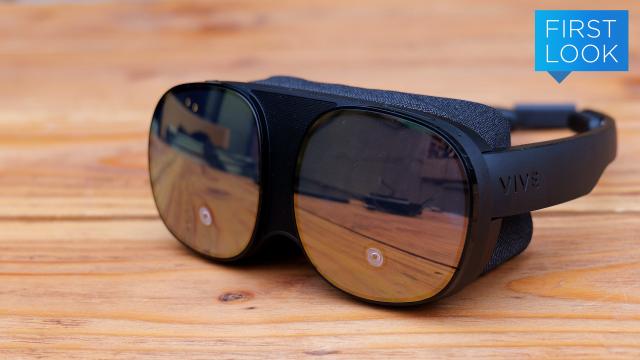HTC Vive’s first real consumer virtual reality headset is here, and while at first glance it seems to be a direct competitor to the Oculus Quest 2, the Vive Flow has the potential to be more of a mainstream headset — but it will cost you.
The Vive Focus 3 is largely intended for enterprise customers, so we were curious to see what the first Vive VR headset for regular folks would look like. The Flow, which costs $749 in Australia, has a lot in common with the Quest 2, but HTC is taking a slightly different path with the design, making it lighter and easier to wear — and maybe even more relaxing, too.
Instead of a traditional goggle-style headset, the Flow was created to fit more like a pair of sunglasses, so there’s no awkward strap on top of your head. Sure, the Flow is a relatively big and bulky pair of sunglasses that make you look like a bug, but they fit more like sunglasses nonetheless.

On a spec-for-spec basis, the Quest 2 seems to have a slight edge, with the Vive Flow topping out with a 75Hz refresh rate (versus up to 120Hz for the Quest 2), and a 1600 x 1600 per eye resolution (compared to 1832 x 1920 per eye for the Quest 2), though the Flow does counter with a slightly wider 100-degree field of view (versus 89 degrees for the Quest 2).
But more importantly, with a body that weighs just 6.6 ounces (compared to more than a pound for the Quest 2) and no strap that goes around the back of your head, I found the Flow really is much easier to quickly put on and take off. HTC also built 3D spatial speakers into the arms of the Flow, so there’s no need to fumble around with separate headphones, though you do have the option of hooking up your own Bluetooth audio devices if you want.

One of the main tricks HTC used to make the Flow so light is in ditching a built-in battery. Instead, there’s a short USB-C cable that extends out to one side, allowing you to plug in a portable battery pack and stash it in a pocket, or use the included clip to tuck the battery into your waistband.
Another key difference between the Flow and the Quest 2 is that the Flow doesn’t come with controllers. Instead, you simply pair your Android device (sorry, iPhone users) to the Flow to turn your phone into a virtual controller that you can use to navigate and select menu items in VR. Another benefit of pairing your phone is that, while it uses Bluetooth for motion controls, it can pair to the Flow via Miracast for displaying content, so you can use your phone in VR and do things like watch Netflix, YouTube, and any other streaming video apps on a giant virtual screen.

The Flow doesn’t have full compatibility with the existing Viveport catalogue, but it will launch with support for around 100 different apps and games. But aside from playing typical VR games, HTC is hoping people will use the Flow as a relaxation and meditation device, so you can grab a calming 20-minute break in the middle of the day or in the midst of a raucous household.
And by making the Flow so lightweight and streamlined, HTC is also pushing the Flow as an accessibility tool. The company is working with developers such as MyndVR, which is using Flow headsets as therapeutic devices for seniors with Alzheimer’s to help in relaxation and to reduce feelings of isolation in long-term care facilities.
I had a short time to test the Flow out, and I really do like how easy it is to use, and how it makes the process of getting into (and out of) VR such a cinch. If you haven’t used previous standalone VR headsets, using your phone as a controller still feels really intuitive, and also comes with the bonus of not having to lug physical controllers around with you all the time, so it feels more portable than the Quest. HTC also includes built-in pass-through cameras you can activate with the touch of a button, though I still wouldn’t recommend trying to use them while walking around.

As an even more portable and streamlined standalone VR headset compared to the Oculus Quest 2, I find that the Flow has enough twists and different features for it to carve out its own niche. Unfortunately, with a higher starting price of $749 (the Quest 2 starts at $479), you will be paying a premium for that added freedom and flexibility.
To help make Flow-compatible VR apps easier to find and access, HTC Vive is also offering a special Viveport subscription that costs only $8.99/month. Preorders for the Flow open today, with shipments slated to begin sometime in November.

Leave a Reply